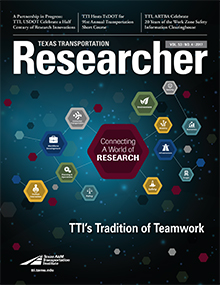For years, Gene Hicks thought there had to be a better way to count the number of vehicles traveling his state’s roadways. As director of the Minnesota Department of Transportation’s (MnDOT’s) Traffic Forecasting and Analysis Section, Hicks oversees the tedious task of laying out road tubes at approximately 33,000 sites (about 12,000 each year) to determine traffic volumes. A traffic tube counter tallies each pulse of air generated when a tire runs over the tube.

Each summer, MnDOT spends about $500,000 statewide to collect two days’ worth of traffic counts at each site. Hicks thinks Big Data can help supply a more efficient, extensive and cost-effective solution.
“The counts we get are very accurate although they only represent two days of traffic for the entire year,” Hicks points out. “In this technological age, the way we do it — the way most states do it — seems pretty low tech.”
So what’s the big deal about Big Data? Numerous transportation data providers collect all kinds of information generated from global positioning system, Bluetooth®, their own subscribers, and supplemental data they purchase from location-based service providers. The companies generate speed data estimates, traffic congestion estimates and origin-destination information.
The question is, can these companies also generate accurate traffic counts for MnDOT and other state departments of transportation (DOTs) from the data they already collect? States need to know precise numbers so they can manage their roadway systems with capacity analysis studies and travel forecasts. Every state is also required to report annual traffic counts to the Federal Highway Administration, so leveraging the power of Big Data can help them meet federal requirements.
“Years ago, I proposed a MnDOT research project to determine whether traffic counts could be gathered from Big Data, but the idea was not taken seriously,” Hicks says. “Last year, when I proposed the project again, it was funded. And that’s when the Texas A&M Transportation Institute [TTI] joined our project.”
Like Hicks, Shawn Turner, head of TTI’s Mobility Analysis Division, had often wondered about the possibility of generating traffic counts from the information gleaned from data providers. Turner and his team acted as intermediaries for MnDOT, consulting with companies about the idea.
“Their databases are a gold mine of information. But we wanted to find out if they could dig out traffic count numbers and develop a product from this raw material,” Turner explained. “Ideally, the product would be a web-based, point-and-click interface subscription in which a DOT or municipality could click on a specific roadway to display traffic count information in real and historic time.”
As part of the now-completed project, Turner talked to numerous companies about developing a traffic count product and was encouraged when he found out that some of the companies — one in particular — had already been discussing the idea internally.
StreetLight Data, a Big Data analytics company based in San Francisco, began working with TTI and MnDOT and developed a beta version of a product that estimates traffic volumes. TTI then compared the numbers to known Minnesota road volumes to determine accuracy.
“Some of StreetLight Data’s numbers were within acceptable error ranges, but on lower-volume roads especially, the numbers were not within the acceptable range,” Turner says. “However, for a first try, this is very promising. I’m confident that with some fine-tuning and analytical enhancements, the company will get a lot closer.”
In fact, since the project was completed, Streetlight Data reports there’s been plenty of progress.
“With each iteration, we’ve developed new statistical and optimization techniques that include population adjustment factors and mixes in new data sources,” says Laura Schewel, StreetLight Data’s chief executive officer. “I think we’ll have a final product to offer by the end of the first quarter of 2018.”
Meanwhile, results of the MnDOT study will be published soon. StreetLight Data has unveiled a beta product for evaluation by users, and Turner has been asked to help with a similar project being conducted by the I-95 Corridor Coalition, an alliance of East Coast states and agencies. MnDOT is waiting to see what products will emerge.
“I think our project gave a boost for companies to develop accurate volume-data products. Having something like this will benefit all DOTs,” Hicks says. “Five or six years ago, people thought I was crazy. Now, it looks like it’s going to happen, and they are getting pretty excited.”

